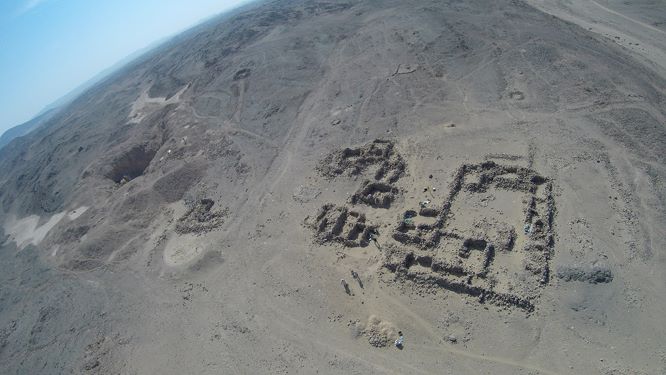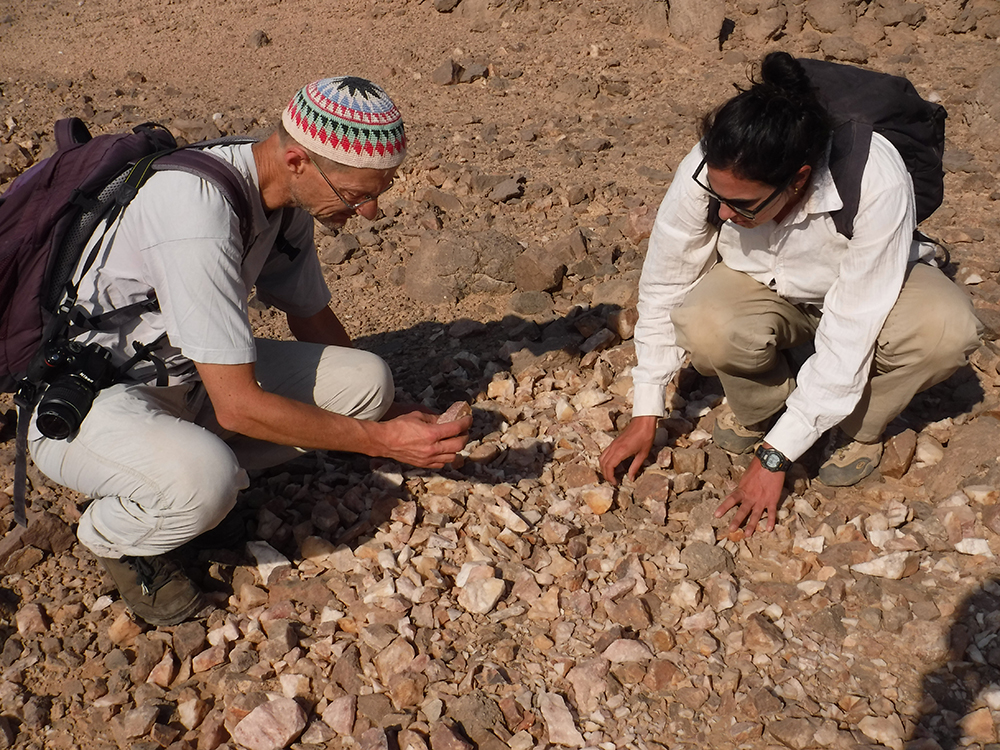Intro to Wadi el-Hudi
What is Wadi el-Hudi?

Wadi el-Hudi is an area of Egypt's Easter Desert southeast of Aswan that was, in ancient times, a center for mining because of its unique geology. It contains dozens of archaeological sites dating from the Paleolithic Period (about 200,000 years ago) to the Islamic Period (about 1,000 years ago) that stand like time capsules in the desert. Ancient Egyptian monuments are the most prevalent, consisting of walled settlements, amethyst mines, and rock inscriptions dating to the Middle Kingdom (c. 2000-1700 BCE) and the Roman Period (c. 1st to 4th centuries BCE-CE). The archaeology is preserved to an astonishing degree; walls stand to their original heights of two meters, ancient pottery covers the surface, and many inscriptions are carved into boulders surrounding the settlements and mines.
Have there been other expeditions to Wadi el-Hudi?
Prior to our expedition, geologists and archaeologists had inspected Wadi el-Hudi only intermittently since 1917 when Geologist Labib Nassim discovered the ancient archaeological sites. In the 1940s, the Egyptologist Ahmed Fakhry conducted a survey of the area, where he identified 14 archaeological sites and recorded over 100 inscriptions. Fakhry published his drawings and photographs of Middle Kingdom inscriptions in 1952, which brought the importance of Wadi el-Hudi to the attention of Egyptologists. Later in 1980, Ashraf Sadek completed the publication of Fakhry's initial work. Ten years later, archaeologists began to work at Wadi el-Hudi when the sites were briefly visited by Ian Shaw, Robert Jameson, Rosemarie Klemm, and Dietrich Klemm in the 1990s, as parts of larger studies of Ancient Egyptian mining operations. But on the whole, when the Wadi el-Hudi Expedition began working in 2014, there was still much to be discovered.
For earlier publications see our publication page.
The Wadi el-Hudi Expedition builds on the work of earlier scholars and is the first project to holistically examine the site through analysis of textual evidence, architecture, material culture, and scientific analysis.
Why did the expedition begin?
The Wadi el-Hudi Expedition was launched in 2014 to record and conserve the monuments at Wadi el-Hudi. Fakhry's earlier work brought to light half of the surviving inscriptions and briefly mentioned the architecture and archaeology. His and Ian Shaw's preliminary work at Wadi el-Hudi showed that there was great potential for the inscriptions and archaeology to address central questions regarding mining and the history and organization of the ancient Egyptian state. Indeed, far beyond its importance for the study of mining expeditions, Wadi el-Hudi has the potential to change much of what we know about the political and social history of Ancient Egypt.
Our Expedition seeks to answer a variety of questions about the history and chronology of the Middle Kingdom, the organization and supply of state-sponsored mining expeditions, the mechanics of semiprecious stone mining, interactions between Nubians and Egyptians, provisioning of material support in state-sponsored projects, literacy among Ancient Egyptian administrative and military classes, ancient slavery and prison laborers, and much more.
Since 2014 we have conducted five seasons of archaeological research. (See below to learn about what we have discovered.) And we eagerly await the opportunity to do more significant research in the next season. We are proud to work with the Egyptian Ministry of Antiquities and the Aswan Inspectorate to discover, study, and conserve monuments in the Eastern Desert for the preservation of Egyptian cultural heritage. Dr. Kate Liszka, California State University San Bernardino, directs the expedition and is supported by Co-Directors Bryan Kraemer, Chief Surveyor and Epigrapher, as well as Dr. Meredith Brand, Chief Ceramicist.
What has been discovered at Wadi el-Hudi?
Since 2014, the Wadi el-Hudi Expedition has been mapping, documenting, and excavating 41 archaeological sites so far discovered. We have fully mapped 11 archaeological sites, identified 25 new archaeological sites, discovered over 100 new inscriptions, and brought thousands of artifacts to the Egyptian Ministry of Antiquities' storage magazine for future study and conservation. We have also conducted 11 test excavations at four archaeological sites to get a sense of how people lived in the Eastern Desert and how the central administration oversaw these ancient mining operations. We discovered 14 new and historically significant stelae (or inscribed monuments) as well as 45 Demotic and Greek inscriptions on ancient ostraca (bits of broken pottery or stone that were used much as we use note paper today) that will help rewrite the political and social history of mining in Ancient Egypt. The initial seasons mark the beginning of a long-term effort to investigate these archaeological treasures in the desert.
See here for a more in-depth look at the largest mines and settlements in Wadi el-Hudi where much of our excavations and mapping efforts have been focused.
What will be lost without more research at Wadi el-Hudi?
Wadi el-Hudi is an important part of Egypt's cultural heritage with unique inscriptions and archaeology that are crucial for understanding Egypt's history. The high degree of preservation at Wadi el-Hudi sites enables us to reconstruct details of life and work at these sites in great detail. This high degree of preservation can provide information that can answer questions about all of Ancient Egyptian culture, society, and history, not just about mining expeditions. In order to glean the most amount of data from the sites, we must work methodically and take our time to excavate and record the over 41 sites in Wadi el-Hudi. After five seasons, there are 20 promising archaeological sites that still need to be mapped, photographed, and excavated to learn about how people lived and how the Egyptian state managed them in the desert. These excavations will continue to lead to highly important historical findings, such as more inscriptions related to the Egyptians and Nubians in these mining expeditions.
Excavations and surveys are only part of the story. With every survey and excavated square, we uncover thousands of artifacts that need to be analyzed and carefully studied. This work includes studying plant remains, animal bones, mining debris, stone tools, charcoal, and pottery that will allow us to understand how people at Wadi el-Hudi lived, what they ate, where they got their food and other material goods from, the ancient environment, the process and technologies of mining, the dates the sites were occupied, and so much more.
As an archaeological zone in the desert with significant importance for cultural heritage, it is a major goal of the Wadi el-Hudi Expedition to conserve and protect the monuments and inscriptions. We also need to conserve and restore the hundreds of fragments of stones belonging to 11 stone stelae with important inscriptions. We hope to put these stelae back together again for future study and display in Egyptian museums.
Modern development in the area of Wadi el-Hudi, however, threatens the archaeological record. Without funding for future archaeological work and conservation, all of this information about how people lived, worked, and died on mining expeditions will be lost forever and the sites will not be preserved for future generations.
Is Wadi el-Hudi under threat?
YES! Wadi el-Hudi is under imminent threat of destruction due to modern illegal mining and pillaging in the Eastern Desert as well as the reopening of legal mining operations near the ancient mines. These activities threaten to destroy the architectural remains of the ancient mining settlements, their artifacts, and their inscriptions. The Wadi el-Hudi Expedition is working against the clock to record as many of these monuments as quickly as possible. Despite the fact that the monuments have survived for thousands of years, the region will be forever changed within a few years' time by modern development. We must study these monuments now because information irreplaceable for its quantity and quality will disappear soon. Now is our only chance.
-- Sent from my Linux system.




No comments:
Post a Comment